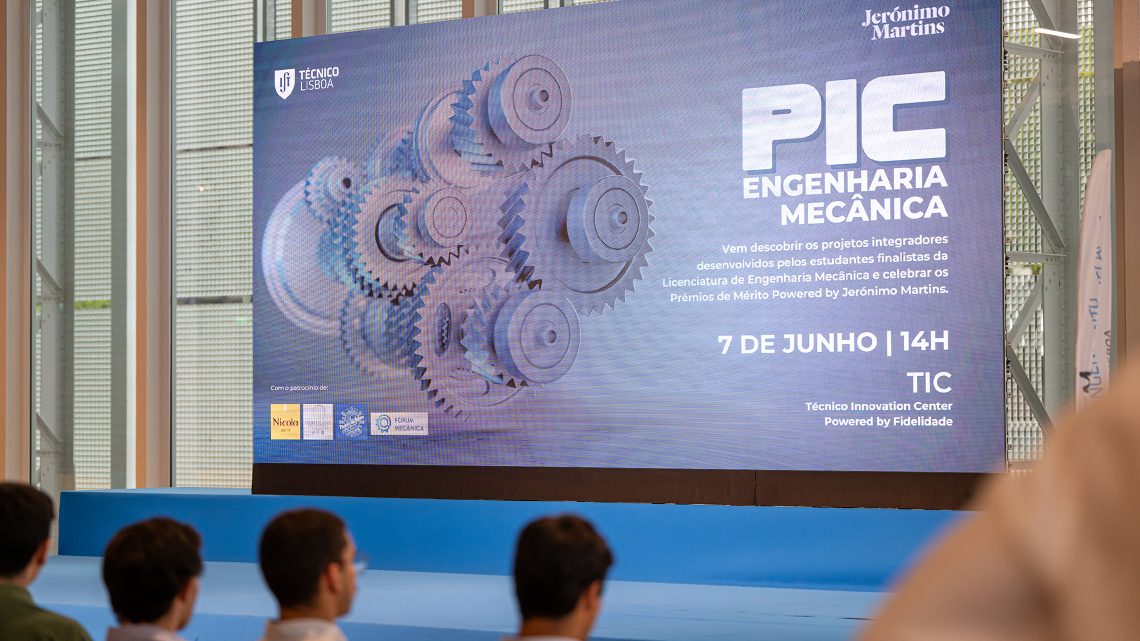Mechanical Engineering students present Integrative Projects
Three 1st Cycle Integrative Projects (PICs) honoured the work carried out by Mechanical Engineering students during their undergraduate programme at Técnico.

‘Seeing the Técnico Innovation Center powered by Fidelidade welcome 140 Mechanical Engineering students in its inaugural year is exciting’ said the President of Técnico Rogério Colaço, on 7 June, recalling students in the audience that they are ‘the first generation to have the 1st Cycle Integrative Project (PIC) curricular unit in its entirety’.
These final-year students in Mechanical Engineering had the opportunity to take part in Técnico’s 1st PIC symposium, an event where the 17 groups of students presented – orally and through scientific posters – the projects they had developed over the course of four months, which merged the lessons learnt over the last two and a half years and put them into practice in this end-of-course curricular unit (UC). As Rogério Colaço explained in his opening speech, the idea of the PICs is to ‘allow students to consolidate their 1st cycle learning’, by putting them into practice.
Among the projects presented were electric and hydrogen-powered vehicle initiatives, new urban mobility solutions, manufacturing and assembly line management systems, a Formula Student prototype, a self-powered oceanographic buoy, two 3D printers that use chocolate as a raw material and many other ideas that represent the culmination of the motivation and knowledge acquired throughout the Mechanical Engineering Undergraduate Programme.
Sofia Teixeira de Freitas, who teaches the 1st Cycle Integrative Project curricular unit, said that ‘it is with great pleasure and pride’ she sees the result of the projects and celebrates the end of the students’ degree. ‘Each professor posed their problem; “we want to solve this” – that’s what we call project-based learning,’ she explained, considering that through this ‘active learning,’ the student becomes the centre of the process, rather than a professor who explains the subject.
Among the 17 groups of students presenting their projects, three were honoured with awards sponsored by the Jerónimo Martins group. The miniFIONA project – a small electric vehicle for transporting cargo – won the main award. In her acceptance speech, the team representative described this PIC as a ‘constructive’ experience. The two honourable mentions were awarded to Integrated Blue Carbon Sensing and Monitoring System for Wetlands (Sustainability) and Wave Energy Charger for autonomous underwater vehicles (Innovation). The selection was based on the assessment of a jury external to the curricular unit, made up of members from the academic and business community.
List of participating groups:
- Group 1 – Plastic deformation manufacturing system
- Group 2 – Thermal processing manufacturing system
- Group 3 – BuZoo – A new solution for sustainable mobility in zoos
- Group 4 – Busy – Sustainable and accessible mobility
- Group 5 – Self-powered oceanography buoy
- Group 6 – Wave energy charger for autonomous underwater vehicles
- Group 7 – Zero-emission minimobility vehicle
- Group 8 – FST14 prototype design
- Group 9 – Soilcarbon – Integrated carbon sensing and monitoring system for sustainable land management
- Group 10 – Integrated Blue Carbon Sensing and Monitoring System for Wetlands
- Group 11 – ECOTUG – Electric vehicle for taxiing aircraft on runways
- Group 12 – H2 Aircraft Tug – Hydrogen-powered aircraft towing vehicle
- Group 13 – Large scale chocolate 3d printer
- Group 14 – Multi-colored chocolate 3D printer
- Group 15 – miniFIONA
- Group 16 – superFIONA
- Group 17 – Intelligent flexible manufacturing system
